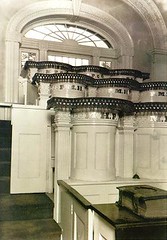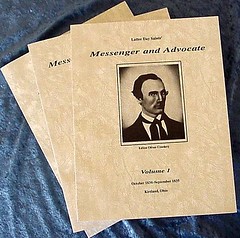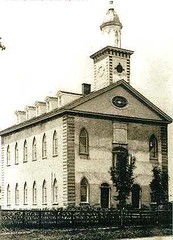Give Us Your Temple . . . But Keep Your Thrift Store
When the LDS Church unveiled plans for a hillside temple, Draper welcomed the idea with eagerness and enthusiasm.So, the city council in February 2005 unanimously changed a zoning ordinance to pave the way for the Temple; but, the same council now proposes an ordinance completely banning a thrift store, the only purpose of which is to help those less fortunate in society.
Same can't be said for church-owned Deseret Industries. The Church of Jesus Christ of Latter-day Saints has visions of building one of its thrift stores east of Interstate 15 near Draper's main drag.
Trouble is, the City Council is considering an ordinance that would restrict large secondhand-stores (more than 5,000 square feet) to a commercial business park zone west of I-15, away from Draper's retail heart.
"I'm not sure [shopping at the DI] is a service a lot of our residents are looking for, given our demographics," Councilman Jeff Stenquist said.
Earlier this year, the council ordered city staffers to look at creating a zone to regulate secondhand-stores. The result: a proposed ordinance that would prohibit large outlets from all but the business park zone. And thrift stores - with outdoor storage and nighttime drop-off - would be barred from Draper altogether.
The city's Planning Commission endorsed the plan in January.
Deseret Industries was founded in August 1938 after the First Presidency issued a letter calling for:
"[C]ontributions of clothing, papers, magazines, articles of furniture, electrical fixtures, metal and glassware" from each household. The letter explained that the project would be known as Deseret Industries, and that the organization would make "periodic collections of these materials from homes…and employ men and women to sort, process, and repair the articles collected for sale and distribution among those who desire to obtain usable articles…at a minimum cost."Through out the years, D.I. has served a dual purpose: It employs those who are unemployed or otherwise unemployable, and serves as an intregal part of the LDS welfare program helping those who are less fortunate than some of those more economically advantaged residents of say Draper, UT:
The Deseret Industries program was implemented specifically for the benefit of members who could not obtain employment elsewhere, and its initial work force consisted primarily of the unemployed and elderly. It was operated under the umbrella of the Church Security Plan—now Church Welfare services—and continues as an integral part of the Church Welfare system. Church leaders use Deseret Industries not only for employment training but as a resource for clothing and household items for needy members.
The Deseret Industries program still focuses on those with disabilities and those who have other social, employment, and economic challenges and obstacles to overcome. An estimated 60-70 percent of the people in the program are somewhat limited physically, mentally, emotionally, or socially. In 1980, Deseret Industries placed about 240 people into jobs with private companies. In 1989, it placed more than 700.People needing training are usually referred to Deseret Industries by a Church leader. A program for each person is written with the individual's supervisors and rehabilitation workers. It incorporates personal and work-related goals and is closely monitored. Local Church members sometimes receive callings to help with training and rehabilitation.
Most Deseret Industries programs are more closely related to work adjustment than to skills training. Trainees get the experience of entering the workplace every day, being on time, learning to get along with coworkers, and taking directions from supervisors. Deseret Industries is not set up to train people to be journeymen plumbers or electricians, for example, though people may get experience doing these types of things.
The Draper City website touts the city as:
Draper City is now one of the most desirable areas to live in the state of Utah. New businesses are coming to town. Beautiful homes are being built. Community centers and churches are being added into the mix. And the historic charm remains.Well, I can certainly see how the city council would not want to tarnish "one of the most desireable areas" in all of Utah with a retail outlet that assists the poor, the unemployed, the disadvantaged, and on top of it all doesn't generate one dime in sales tax to the city coffers. Of course, the Temple doesn't generate much sales tax either--but I suspect it fits into the city fathers' planning ideals more appropriately than does a second hand thrift store. If you have an opinion, and want to share it with the mayor, his email address is darrell.smith@draper.ut.us
I can't help but think of Christ's point in Matthew 25:35-40. "Inasmuch as ye have done it unto one of the least of these my brethren, ye have done it unto me."







4 Comments:
I don't see a huge demand for the DI's services in Draper.
But Draper definitely needs a DI dropoff point.
Great blog!
Not being a Utahn, I have no knowledge of Draper in particular, but frankly that's ridiculous. The idea of the church being 'played' in soem municipalities efforts to be a 'desirable' place to live. Ugh.
citizen 451: Thanks for stopping by. You may be right about the demand for DI in Draper; but, still the attitude of Temple yes--DI no? Thanks for your compliment. I've been by yours as well, and enjoy it too. I'm going to link How Do You Like Them Appellates and The State of The Beehive at my personal blog, Guy’s Blog. Stop by anytime.
Nd: The idea that we'll take your temple but not your thrift store is UGH! Thanks for stopping by.
Post a Comment
<< Home